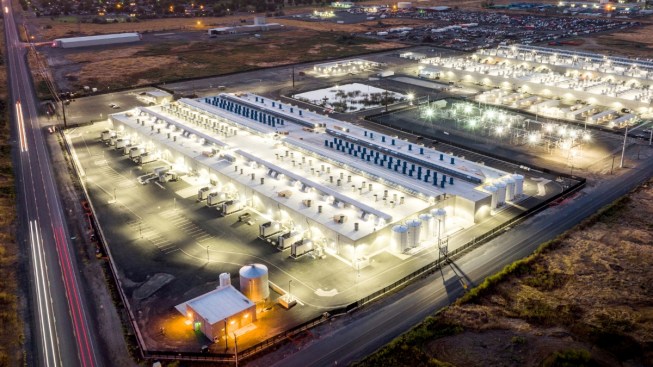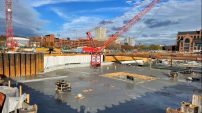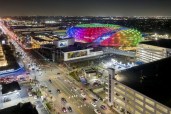The built environment’s march to a low carbon future has crossed another threshold.
A new Gensler-designed Amazon AWS data center campus in northern Indiana uses a concrete mix that slashes GWP (Global Warming Potential) by up to 60% over standard regional mixes. This sustainability advance meets ASTM C1157 compliance and Open Compute Project certification.
The $11 billion AWS campus, the largest capital investment in Indiana history, is a mammoth 10-year project. Build-out is expected to include as many as 30 large data centers spread over a 1,200-acre site near New Carlisle.
Low Carbon Requirement
Low carbon concrete is a project imperative, reports Ryan Cialdella, vice president of innovation and market development for Ozinga, a project contractor and developer of the cement blend that’s key to the largest known implementation of ASTM C1157 performance hydraulic blended cement.
“Everyone was aligned in using low carbon concrete,” explains Cialdella. “Ultimately, it comes from the top down. The owner said ‘We want this. You figure it out.’ AWS was all-in on minimizing embodied carbon.”
Creating just the right mix that met or exceeded strict performance criteria wasn’t easy, admits the veteran concrete industry leader.
“There are a lot of variables,” says Cialdella. “Different plants. Different aggregates. Different trucks with different mix rates. Could we reliably replicate and at scale? We had to answer a lot of questions. The owner allowed us to iterate and really hone in on the best solution.”
6 Documented Results
For architects, engineers, general contractors, and owners looking to meet 2030 sustainability goals with minimal project design and performance concerns, the Indiana hyperscale project gives a new impetus to low carbon concrete. A trusted manufacturing template for producing low carbon concrete has been established.

So far, the project team has documented at least six results:
- A cement blend developed by Ozinga called CarbonSense Cement shows a GWP of just 103 kgCO2e/yd3, 60% less than the benchmark NRMCA V3 2020 Great Lakes Midwest Regional mix.
- Slag replacement demonstrates an embodied carbon reduction of 1487 tCO2e.
- Total carbon emission savings are equivalent to powering 560 homes for a year or the carbon offsetting power of 2,695 trees over a year.
- OCP test results validated project strength capabilities and performance, sanctioning the adoption of the 1157 mix for all data center foundations, along with slag replacements for interior slab-on-ground applications.
- Despite sub-freezing temperatures, lifting strength was achieved by day seven in field tests, confirming adaptability.
- The mix with just 25% slag outperformed a baseline 100% Type 1L cement in cold weather conditions.
No cement mix is right for every application and geography. What the $11 billion AWS project shows is how nearly any major infrastructure project can now be sustainably transformed using low carbon concrete production methods.
Growing Momentum
“The idea of low carbon concrete is gaining rapid traction,” says Cialdello. “For the design community, it means opening their minds to the possibilities it presents and specing accordingly. OCP validation was critical to our project. AWS now insists the GC use low carbon concrete in more and more applications.
“Today three other hyperscalers are in various stages of pilots with this exact same concrete. It’s easy to see why owners, architects, and specifiers are working with us like never before to help end carbon emissions.”
Learn more about how you can design more sustainably with concrete performance and resilience.


